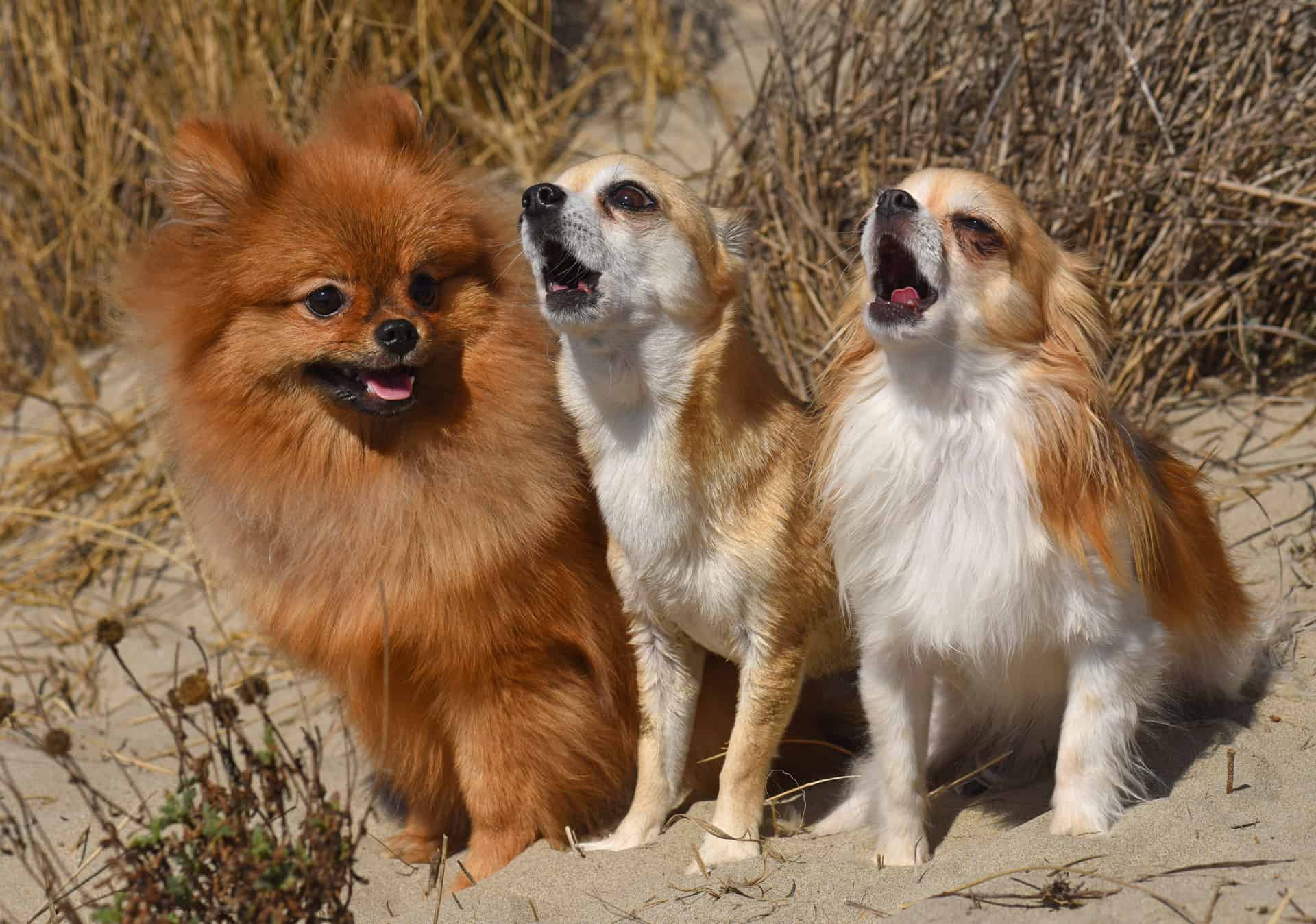Social Barking: Joining the Canine Chorus
I apologize for the confusion. Without more context or information about the content, it’s difficult to suggest an accurate heading. Could you please provide more details about what the text is about or what it covers in order for me to suggest an appropriate heading?
Understanding Canine Vocalizations
Dogs are social! They communicate through vocalizations. Different barks and growls each have their own meanings. It’s not always easy for us humans to understand. So, let’s see what these vocalizations mean.
Barking is one type. It can indicate many things. Growling is another. It often means a warning!
The Purpose of Barking
Dogs bark to communicate with other dogs and humans. It can be a warning of danger, a way to express emotions, or a way to get attention or play.
Social barking is when a dog barks after hearing another canine. This lets other dogs know their location and strengthens social bonds. To understand a pup’s emotions, it’s important to recognize barking types.
Pro tip: Train your dog to bark only when necessary. This avoids excessive barking and keeps neighbors happy!
Different Types of Barking
Dogs bark to communicate. One type of barking is social. This happens with a group of dogs, often instinctively.
Examples:
- Howling: Dogs howl to show presence and territory. It’s also a way to talk to other dogs from far away.
- Excitement Barking: Dogs bark when happy or excited. E.g. when their owners come home.
- Alarm Barking: Alarm barking warns of potential danger, real or imagined.
But, if social barking continues, it may mean anxiety or distress. So, it’s important to watch your dog’s barking behaviour. Check if anything is wrong.
How Dogs Learn to Bark
Barking is a way dogs communicate with us and other dogs. It’s a learned behavior. Social barking is when a dog joins in with other dogs’ barks. It could be due to excitement, fear, or anxiety.
We can control excessive social barking by training our dogs with positive behavior reinforcement. This could mean rewarding the pup when it stops barking, socializing it, and reducing triggers that cause excessive barking.
Understanding our dog’s vocal communication can help us form a strong bond between us and our pet.
Communicating with Your Dog Through Barking
Have you heard about owners who believe they can understand their dog’s bark?
This may appear like a wild dream, but research is showing that there is truth to it. Canines are capable of communicating in a very intricate way via different barks. Let’s discover what social barking is and how you can communicate better with your pooch!
Establishing a Vocabulary
Creating a special language with your pup is important for better communication and understanding their needs. Barking is one of the ways dogs talk, and “social barking” is when they join the “canine chorus“.
To make your own language:
- Give certain words or phrases to certain actions or behaviors. E.g. ‘potty’ for when they go to the bathroom.
- Use your body and voice consistently to reinforce the language.
Social barking is when your dog barks with other dogs or people. To join the chorus, copy their pitch and sound. Do this in a controlled environment.
With practice, you will have a strong connection with your pup and be able to talk to each other easily.
Pro tip: Don’t let your dog bark too much. Reward them with attention when they use the language effectively.
Reinforcing Appropriate Behaviors
Reinforce correct behaviors: that is the secret to speaking to your pup with barking, particularly social barking. When mutts bark in response to other canines barking, it’s a way for them to communicate and bond. Here’s how to reinforce when your dog is social barking:
- Wait for a pause in the barking and then command, for instance “enough” or “quiet”.
- When your doggo listens to your command and stops barking, quickly give them verbal affection and a treat as an award.
- Use positive reinforcement frequently when teaching your pup to promote desired behaviors such as calming down when commanded.
Keep in mind that dogs are social animals and social barking is a natural action. By reinforcing appropriate behaviors like listening to commands and calming down, you can converse with your dog through barking and make your relationship better.
Addressing Unwanted Barking
Unwanted barking from your pup can be a bother not just to you, but your neighbors as well. Dealing with it quickly will make for a peaceful life with your dog.
Communicating With Your Dog Through Barking: Dogs bark to express different feelings, like hunger, anger, thirst, or playfulness. Figuring out what your dog’s barking means can help you know their needs right away.
Social Barking: Dogs are social animals who like to yap together. They bark in excitement when they play with other dogs or see people. You can join in and help them have a positive time.
Pro Tip: Teach your dog to connect certain actions to staying quiet. For example, when you put their food bowl down, they should stay quiet until you say they can eat. Or, when you take them out on the leash for a walk or playtime, they should do it with no noise. Reward them when they act the way you want them to.
Socializing Your Puppy Through Barking
Puppies bark naturally. It’s how they communicate and get to know their doggy friends. Teach them proper barking manners and they will be more socialised and balanced. Here are some tips:
- Reward them with treats when they bark less.
- Train them to only bark when necessary.
- Give them attention regularly.
- Use verbal commands when they bark too much.
- Make sure they get enough exercise.
Puppy Playtime
Puppy playtime is essential for socializing! Barking is an important canine communication tool. Dogs bark when they hear other dogs. As a pet owner, use social barking to train your pup.
Here’s how:
- Take your puppy to a park or dog-friendly place.
- Encourage your pup to bark through play, like fetch or tug-of-war.
- Play recorded sounds of other dogs barking. Make a positive association with the sound.
- Also, train your pup to differentiate between friendly and aggressive barking.
Pro Tip: Socialization and training can prevent excessive barking. Result? Happier, healthier pets and owners!
Socializing with Other Dogs
Socializing with other dogs is a must for a puppy’s social growth. Barking is one of the ways puppies communicate and socialize. Here are some tips:
- Expose your pup to other dogs in a secure environment.
- Playtime is a great chance for your pup to interact and learn.
- Don’t punish barking – it might cause fear and low self-esteem.
- Keep an eye on barking – it should not become aggressive.
Socializing through barking helps puppies learn how to interact and become confident adults.
Proper Socialization Techniques
Socializing your pup is super important for their growth and happiness. Barking is natural for dogs, but too much or unfriendly barking can be a problem. On the other hand, social barking is a great thing that can help your pup become more confident and sociable. Here are some tips to help teach your pup appropriate social barking:
- Take your pup to places where other dogs are around, like a dog park.
- Encourage them to observe other dogs barking and join in a friendly way.
- Reward your pup with treats and praise when they engage in friendly social barking.
- If your pup barks aggressively or too much, remove them from the situation and redirect their behavior in a calm way.
- Remember that each pup has different personalities and preferences. Respect your pup’s needs and comfort level.
Pro Tip: Socializing your pup is a long process that requires patience, consistency, and positive reinforcement. If you need help, ask a professional dog trainer for advice.
The Human-Dog Bond Through Barking
Strolling through the park, you may hear a chorus of barks. But what if both human and canine voices could be heard? That is social barking! This special form of communication between people and their pooches is as vital to their bond as walking, frolicking and cuddling.
Let’s discover how social barking works!
Benefits of Barking with Your Dog
Barking with your pup can be a great way to bond. Plus, it has lots of perks!
- Communication: Barking is a language for dogs. When you bark together, you get to know their ‘words’ better.
- Bonding: Barking brings you closer. Plus, when you do stuff they enjoy, the quality time spent together is even more special.
- Fun: Barking with your pooch can be fun. It eliminates boredom and strengthens the connection between you two.
Pro tip: Don’t let barking become an issue. Don’t let it distract you from your tasks or disturb your neighbors.
Effective Barking Techniques
Dogs bark to communicate, but too much can be a problem. There are ways to control it, though! Here are tips:
- Positive training: Reward quiet behavior. Treats or praise help.
- Teach a “quiet” command: Use a verbal command like “quiet”, and reward when the barking stops. Consistent repetition helps the dog associate “quiet” with silence.
- Exercise and stimulation: Dogs need regular exercise and stimulation to avoid barking out of boredom.
- Socialization: Joining other dogs to bark is normal. Socializing can help dogs bark less at the wrong times.
With dedication and consistency, you can control barking and strengthen the bond with your pup!
Fostering Empathy Towards Dogs’ Communication
Dogs bark socially for communicating a variety of emotions – alarm, joy, frustration and more. Understanding these vocalizations helps humans to build respect and understanding for dogs. Let’s delve deeper and explore why showing empathy to dogs’ communication is beneficial for both humans and canines.
Raising Awareness through Education
Raising awareness of dogs’ communication, specifically social barking, is a powerful way to foster empathy. Joining the canine chorus is not only fun, but it’s also essential to recognizing our furry friends’ needs. Here are some key points to help!
- Social barking is a way dogs communicate with other dogs and humans.
- Understanding context and frequency of social barking can help identify a dog’s emotional state and needs.
- Positive reinforcement training and socialization can reduce excessive barking and improve communication.
By educating ourselves and others about social barking, we can create a supportive environment for our four-legged companions. So, let’s join the canine chorus and make a positive impact on their lives!
Pro Tip: Always approach a barking dog with caution and try to understand the context before taking any action.
Encouraging Responsible Pet Ownership
Responsible pet ownership is essential for a happy relationship between pet and owner. One key part of this is understanding your dog’s barking. Here are some tips:
- Figure out the different barks. High-pitched barking may show excitement, while low-pitched barking could mean aggression or warning.
- Train your dog to respond to commands and reduce too much barking. Use positive reinforcement to reward desired behaviors.
- Respect your neighbors and their need for peace and quiet. Don’t leave your dog alone for too long.
- Exercise your pet regularly so they don’t bark out of boredom or too much energy.
By respecting your pet’s communication and taking steps to control excessive barking, you can ensure responsible pet ownership and a peaceful relationship.
Promoting Canine Welfare and Rescue Efforts.
It’s important to promote canine welfare and rescue efforts. To do this, we need to understand dogs’ communication. We must recognize that barking is a social behavior, and learn to interpret it. Here are ways to join the canine chorus and promote understanding:
- Listen – Pitch and tone of a dog’s bark can tell us their mood and intentions.
- Observe – Watch body language while they bark to gain insight into what they’re saying.
- React – Responding appropriately builds trust and positive communication.
By interpreting barking behavior and responding correctly, we can help rescue efforts and improve canine welfare.
Frequently Asked Questions
1. What is social barking?
Social barking is when a dog joins in with other dogs’ barking, even if they don’t have a specific reason to bark.
2. Why do dogs engage in social barking?
Dogs are social creatures and often engage in behavior that helps them bond with other dogs. Social barking can be a way for dogs to communicate and connect with each other.
3. Is social barking a sign of aggression?
No, social barking is usually just a harmless behavior that dogs engage in. However, if your dog is barking aggressively, it’s important to address the issue and seek advice from a professional trainer or behaviorist.
4. How can I train my dog to stop social barking?
Training your dog to stop social barking can be challenging, but it’s possible with the right techniques. Consistent and positive reinforcement training, such as rewarding your dog for remaining quiet while other dogs are barking, can be effective in reducing their barking behavior.
5. Is it okay for my dog to social bark at other dogs in public?
While social barking is generally seen as harmless, it’s important to be considerate of others in public spaces. If your dog’s barking is disturbing other people or dogs, it may be a good idea to redirect their attention with training or remove them from the situation.
6. Can social barking be a symptom of separation anxiety?
Social barking is not necessarily a symptom of separation anxiety, but excessive barking in general can be a sign of anxiety or stress. If you suspect your dog may be experiencing separation anxiety, it’s important to seek advice from a veterinarian or behaviorist.







